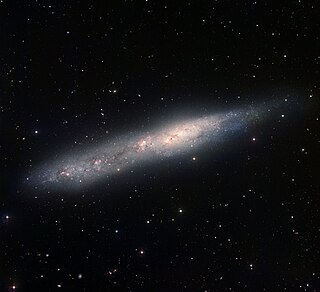
NGC 55, also known as the String of Pearls Galaxy, is a Magellanic type barred spiral galaxy located about 6.5 million light-years away in the constellation Sculptor. It was discovered on 7 July 1826 by Scottish astronomer James Dunlop. Along with its neighbor NGC 300, it is one of the closest galaxies to the Local Group, probably lying between the Milky Way and the Sculptor Group. It has an estimated mass of (2.0 ± 0.4) × 1010M☉.

NGC 404 is a field galaxy located about 10 million light years away in the constellation Andromeda. It was discovered by William Herschel in 1784, and is visible through small telescopes. NGC 404 lies just beyond the Local Group and does not appear gravitationally bound to it. It is located within 7 arc-minutes of second magnitude star Mirach, making it a difficult target to observe or photograph and granting it the nickname "Mirach's Ghost".
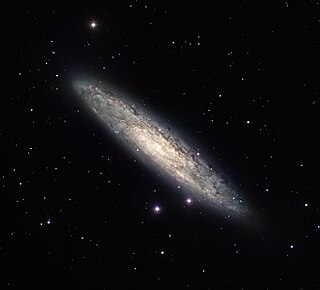
The Sculptor Galaxy is an intermediate spiral galaxy in the constellation Sculptor. The Sculptor Galaxy is a starburst galaxy, which means that it is currently undergoing a period of intense star formation.
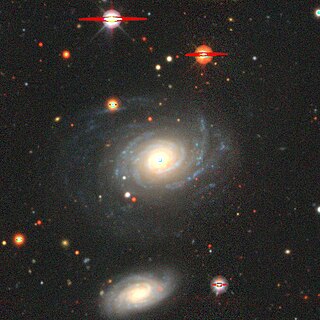
NGC 1 is an intermediate spiral galaxy of the morphological type Sbc, located in the constellation of Pegasus. It was discovered on 30 September 1861 by Heinrich d'Arrest.
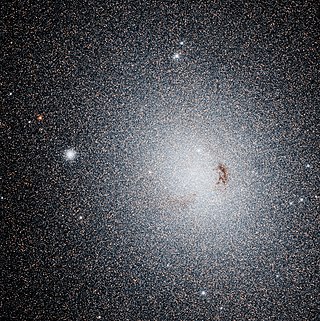
NGC 185 is a dwarf spheroidal galaxy located 2.08 million light-years from Earth, appearing in the constellation Cassiopeia. It is a member of the Local Group, and is a satellite of the Andromeda Galaxy (M31). NGC 185 was discovered by William Herschel on November 30, 1787, and he cataloged it "H II.707". John Herschel observed the object again in 1833 when he cataloged it as "h 35", and then in 1864 when he cataloged it as "GC 90" within his General Catalogue of Nebulae and Clusters. NGC 185 was first photographed between 1898 and 1900 by James Edward Keeler with the Crossley Reflector of Lick Observatory. Unlike most dwarf elliptical galaxies, NGC 185 contains young stellar clusters, and star formation proceeded at a low rate until the recent past. NGC 185 has an active galactic nucleus (AGN) and is usually classified as a type 2 Seyfert galaxy, though its status as a Seyfert is questioned. It is possibly the closest Seyfert galaxy to Earth, and is the only known Seyfert in the Local Group.
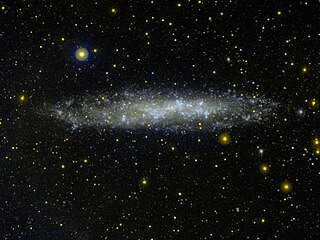
NGC 3109 is a small barred Magellanic type spiral or irregular galaxy around 4.35 Mly away in the direction of the constellation of Hydra. NGC 3109 is believed to be tidally interacting with the dwarf elliptical galaxy Antlia Dwarf. It was discovered by John Herschel on March 24, 1835 while he was in what is now South Africa.
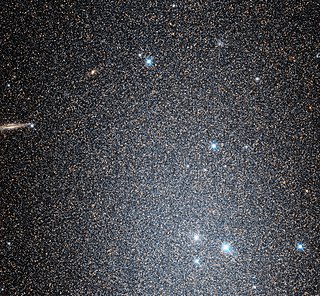
NGC 147 is a dwarf spheroidal galaxy about 2.58 Mly away in the constellation Cassiopeia. NGC 147 is a member of the Local group of galaxies and a satellite galaxy of the Andromeda Galaxy (M31). It forms a physical pair with the nearby galaxy NGC 185, another remote satellite of M31. It was discovered by John Herschel in September 1829. Visually it is both fainter and slightly larger than NGC 185. This means that NGC 147 is more difficult to see than NGC 185, which is visible in small telescopes. In the Webb Society Deep-Sky Observer's Handbook, the visual appearance of NGC 147 is described as follows:
Large, quite faint, irregularly round; it brightens in the middle to a stellar nucleus.

NGC 17, also known as NGC 34, is a spiral galaxy in the constellation Cetus. It is the result of a merger between two disk galaxies, resulting in a recent starburst in the central regions and continuing starforming activity. The galaxy is still gas-rich, and has a single galactic nucleus. It lies 250 million light years away. It was discovered in 1886 by Frank Muller and then observed again later that year by Lewis Swift.

NGC 3077 is a small disrupted elliptical galaxy, a member of the M81 Group, which is located in the northern constellation Ursa Major. Despite being similar to an elliptical galaxy in appearance, it is peculiar for two reasons. First, it shows wispy edges and scattered dust clouds that are probably a result of gravitational interaction with its larger neighbors, similar to the galaxy M82. Second, this galaxy has an active nucleus. This caused Carl Seyfert in 1943 to include it in his list of galaxies, which are now called Seyfert Galaxies. However, NGC 3077, though an emission line galaxy, is today no longer classified as a Seyfert galaxy.

NGC 5102, also known as Iota's Ghost, is a lenticular galaxy in the Centaurus A/M83 Group of galaxies. It was discovered by John Herschel in 1835.

NGC 625 is a dwarf barred spiral galaxy about 12.7 Mly away in the constellation Phoenix. It was discovered on 2 September 1826 by Scottish astronomer James Dunlop. NGC 625 is a member of the Sculptor Group.
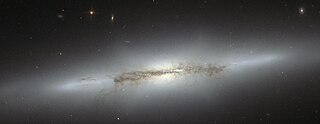
NGC 4710 is an edge-on lenticular galaxy in the northern constellation of Coma Berenices. It was discovered on March 21, 1784 by German-British astronomer William Herschel. This galaxy has a B-band visual magnitude of 11.60 and an angular size of 3.0′ × 0.8′. It is located at a distance of 54.5 ± 3.6 million light-years (16.7 ± 1.1 Mpc) from the Milky Way, and is receding with a heliocentric radial velocity of 1,129 km/s. This is a member of the Virgo Cluster, with a projected offset of ~6° from the cluster center and a cluster crossing time of around two billion years.
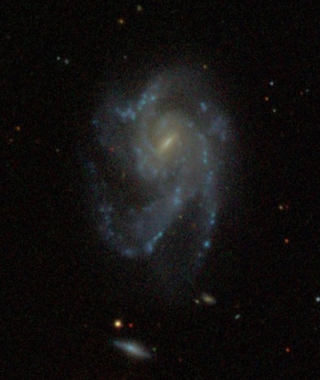
NGC 5579 is an intermediate spiral galaxy in the northern constellation of Boötes. It was discovered on May 1, 1785) by German-British astronomer William Herschel. The galaxy is located at a distance of 179 ± 14 million light-years (54.9 ± 4.3 Mpc) from the Milky Way, and is receding with a heliocentric radial velocity of 3,608 km/s. It is entry 69 in Halton Arp's Atlas of Peculiar Galaxies.
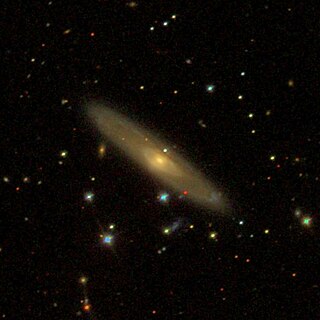
NGC 13 is a spiral galaxy in the constellation Andromeda. It is estimated to be about 220 million light-years away from the Sun. It was discovered on November 26, 1790, by William Herschel.

NGC 27 is a spiral galaxy located in the constellation Andromeda. It was discovered on 3 August 1884 by Lewis Swift. It forms a galaxy pair with the nearby UGC 95.

NGC 50 is an elliptical galaxy in the constellation Cetus with a diameter of 170,000 light-years. It was discovered in 1865 by Gaspare Ferrari. The galaxy is, in comparison to the Milky Way, about 1.5-2 times as large. It is also physically close to NGC 49.

NGC 1022 is a barred spiral galaxy located approximately 68 million light years away in the equatorial constellation of Cetus. It was discovered on September 10, 1785, by William Herschel. NGC 1022 is a member of the Cetus-Aries group of galaxies.
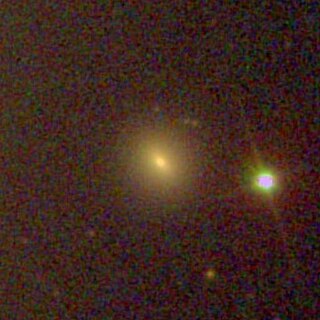
NGC 4467 is an elliptical galaxy located about 78 million light-years away in the constellation of Virgo. NGC 4467 was discovered by astronomer Otto Struve on April 28, 1851. NGC 4467 is a companion of Messier 49 and is a member of the Virgo Cluster.

NGC 4580 is an unbarred spiral galaxy located about 70 million light-years away in the constellation Virgo. NGC 4580 is also classified as a LINER galaxy. It was discovered by astronomer William Herschel on February 2, 1786 and is a member of the Virgo Cluster.

NGC 931 is a spiral galaxy located in the constellation Triangulum. It is located at a distance of circa 200 million light-years from Earth, which, given its apparent dimensions, means that NGC 931 is about 200,000 light years across. It was discovered by Heinrich d'Arrest on September 26, 1865. It is classified as a Seyfert galaxy.




















